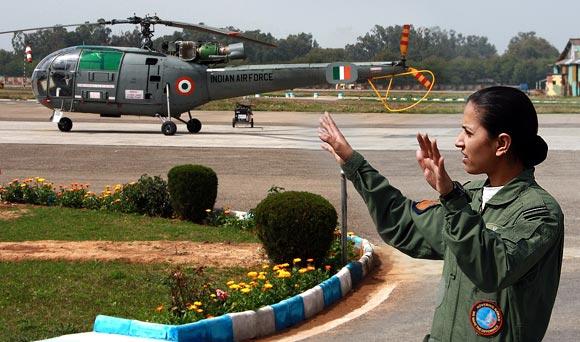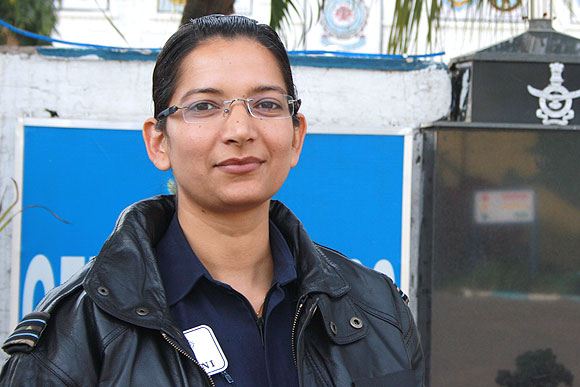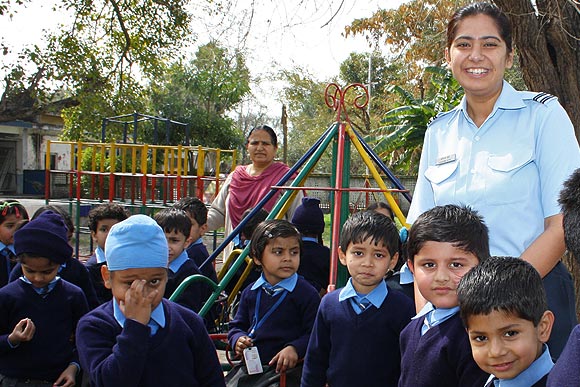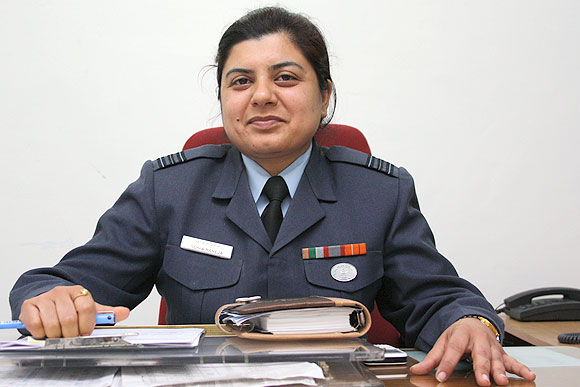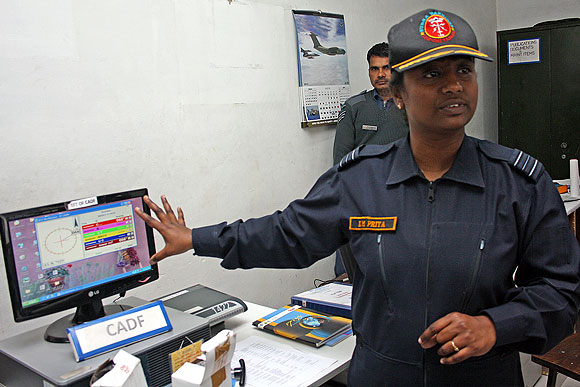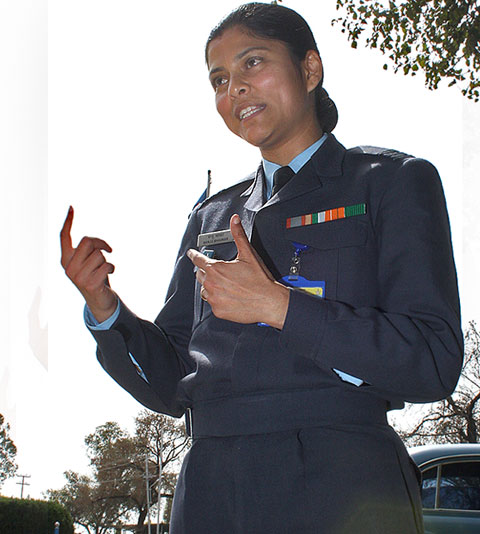 | « Back to article | Print this article |
The women who chose to be different
Nineteen years after the Indian Air Force began inducting women officers, they have become trendsetters, carving a prominent place for themselves in diverse IAF stations across the country.
This year, for the first time, the IAF contingent was led by a young lady officer at the Republic Day parade. Rediff.com's Archana Masih meets some dynamic IAF lady officers who make India proud.
Flying Officer Anupam Chowdhry
Helicopter Pilot
Years in the Indian Air Force: 2
"I don't feel any difference between a man or a woman in my profession. I am doing what I am supposed to do as any other pilot," says Flying Officer Anupam Chowdhry, one of the three lady officers to lead the IAF marching contingent in the Republic Day parade this year, the first time it was commanded by a lady officer.
"The only difference is when I get off the cockpit -- like when I am doing a civilian casualty evacuation -- people do not expect to see a lady pilot and are a little surprised but are always happy to see you and give their blessings."
The officer who flies the Chetak and Cheetah -- the latter for operations above 10,000 feet -- feels the hardest part of her job is during search and rescue operations when she is faced with the dilemma of taking just a few people aboard from among a desperate group of stranded people because the Chetak has three seats and the Cheetah has five.
"We have to decide who to take and who to leave till the next sortie because people who are more critical are to be evacuated first. It is very hard," says the officer who has been detailed for tasks like casualty evacuation, search and rescue, obstruction reconnaissance in military-paramilitary tasks and in civilian eventualities.
Casualty evacuation can be done to assist the military-paramilitary or the civil government. In such situations helicopters are requisitioned at short notice for which they are kept in hot stand-by at all times.
Pilots could also be tasked for search and rescue missions like in an air-crash or when people get lost in trekking-mountaineering or during natural or man-made disasters.
Such flying tasks have taken Flying Officer Anupam to challenging locations like Doda, Kishtwar, Srinagar, Kargil, Leh, Shimla, Manali and Chandigarh.
"At the start of the day we often do not know what the day is going to be like -- how many lives we're going to save. There could be an emergency anytime," says the officer who looks forward to the day when she will be the captain of the helicopter she flies.
For pilots, the degree of difficulty keeps increasing at helipads of higher altitude and at helipads which are restricted, small or inaccessible. Pilots are cleared for carrying out all roles at diverse helipads as they gain more flying experience in the IAF.
The impressive young officer gives glimpses of her experiences, remembering a time when as co-pilot she helped evacuate Border Security Force personnel after a mine blast in Rajouri and took them to a military hospital in very bad weather conditions.
She also mentions the challenges of landing at helipads at 11,000 feet on small sized helipads close to the Line of Control.
Going around the chopper as she does the 'after landing checks', she bears an air of quiet confidence and tells us that the performance of any aircraft in the air depends on how well prepared you are on the ground.
Young pilots in the air force are required to study a wide range of subjects from aerodynamics to aviation medicine and have to keep abreast with the latest developments in aviation. Their professional competence is judged through annual examinations where they are categorised according to their performance.
A small town girl from Uttar Pradesh, the young officer always wanted to be a pilot, but confesses she did not know how to join the air force till she joined college in Delhi.
Agreeing that people's awareness about the air force is limited to 'fighter pilot', she is bemused by some of the responses she has elicited from various people -- some have even asked her if she is an air hostess because she flies or a saleswoman in a mall because she wears overalls!
Her family, friends and those who know her take immense pride in what she does -- the school that she went to wants to invite her as the chief guest some day.
"People respect you if you wear the uniform of the armed forces," says Flying Officer Anupam with a smile, "What could be a better honour."
Please click Next to meet other IAF lady officers...
'We are trained to make split second decisions'
Flight Lieutenant Shalini
Fighter Controller
Number of years in the Indian Air Force: 6
Flight Lieutenant Shalini is a fighter controller, directing fighters like MiGs, Sukhois and combat helicopters on their missions with the help of a radar.
"We are trained to make split second decisions as we monitor the air space. We also maintain separation between our own aircraft so that they are safe and collision free," says the officer at the end of the day's shift.
In a combat situation, fighter controllers are required to direct fighter jets onto the enemy aircraft to shoot it down. Another task they do is to ensure that fighters and helicopters are safe from enemy interceptors.
Her last posting was at a sensitive fighter base close to the international border with Pakistan. Having spent six years in the air force, the officer says she is lucky to be serving at a very interesting time when the Indian Air Force is going through an era of change -- where old radars are being phased out to make way for newer, state of the art radars.
"We get to work on new radars soon after they are inducted," says the officer, who tragically lost her first husband, also an IAF pilot, in a helicopter crash a few years ago and remarried a fellow officer recently.
Hailing from a small town in Uttar Pradesh, Shalini had wanted to do an MBA; her brother had wanted to join the armed forces. Exactly the opposite happened -- she joined the air force and her brother studied management.
A role model for many in her hometown, many children come to her and ask questions about her profession whenever she is visiting during leave.
"Civilians are very fascinated by life in the air force, especially kids who want to know what life actually is like here. It is very motivational for them."
Please click Next to meet other IAF lady officers...
'Many still feel that if you wear specs or are short you can't join the air force'
Flight Lieutenant Karishma Sethi
Education Officer
Number of years in the Indian Air Force: 2
"I met a very fine lady officer who motivated me to join the air force. I must confess the film Lakshya also played a role," says Flight Lieutenant Karishma Sethi who joined the IAF two years ago after completing a MA in psychology.
Faced with the option of either joining the Jawaharlal Nehru University for an MPhil or the Air Force Academy, she decided the latter, egged on by enthusiastic friends who told her -- 'Go, at least so that we can say 'our friend is in the air force'."
As the education officer of the station, in charge of education and training requirements, the young officer says she has loved every moment of the two years spent in the IAF.
One of her duties is managing the Air Force School for the children of airmen and officers.
"I want to continue and grow and mature here. Earlier women could only serve for 10+4 years, but now that women officers can get a permanent commission, girls are no longer looking at the air force as a job, but as a career," says the enthusiastic officer who knows four other girls in her hometown who have joined the air force after she did.
Hailing from a town with a strong military tradition by virtue of being home to the Indian Military Academy, she feels that people largely have a limited view on the armed forces -- where the army only means infantry soldiers who pick up the gun to go into battle and the air force means 'fighter pilots'.
"The knowledge about non flying-supporting jobs is less. Then there are many who still feel that if you wear specs or are short you can't join the air force."
Responsible for the administration of the Air Force School, adjudged as one of the best in the Western Air Command, the officer takes great pride in the school, explaining in detail the plans towards its improvement and speaks of a recent school event when children from 11 other schools were invited to have a look at the aircraft at the air force station to encourage interest.
"Children still want to be doctors, engineers, fashion designers. Very few say they want to join the armed forces, events like these will encourage them."
Looking back at her days at the Air Force Academy, she speaks about the experience with nostalgic fondness. The strict discipline -- reporting at 5.30 am every morning, drills, classes, PT, the squadron spirit -- all of which shaped her and the strong squadron spirit that officers carry on through their lives.
"We have lived together and been through everything together," she smiles, "Your coursemates become a part of your life."
Please click Next to meet other IAF lady officers...
'To command respect you have to compete as equals in every field'
Squadron Leader Sonia Raheja
Administration Officer
Number of years in the Indian Air Force: 11
From the 16th course of lady officers, Squadron Leader Sonia Raheja has spent a decade in the air force; while her younger brother is an officer in the Indian Army.
Since her parents were teachers at the Kendriya Vidyalaya situated in cantonments, she grew up in the atmosphere of the armed forces and wanted to be part of it.
After clearing the Service Selection Board examination at the first attempt, she went to Jorhat in Assam for her first posting which proved to be a memorable two years.
"These past years have given me a very varied experience. You cannot get this kind of exposure in a civilian job in terms of the people you command and the kind of duties you do," says the officer whose duties as the administration officer include the services and maintenance of the station.
In an earlier tenure, she was part of the software development team to create software to store data records of airmen in the air force. One of the other things she has learnt over the years in the air force is adaptability and feels the dynamics of the job is such that it doesn't allow inertia to set in.
Coming from the earlier batches of women officers when ladies in uniform were still a new phenomena in the armed forces, Squadron Leader Raheja feels the biggest challenge for her during those early years was donning a uniform to stand alongside male counterparts and proving that she is as good as them.
"To command respect you have to be as good and compete as equals in every field," says the officer, pointing out to the fact that women officers have proved themselves impressively in the air force which is evident from their increased numbers. In her station, there are 10 lady officers.
Refuting the notion that life is monetarily better outside, she says the air force provides enough to lead a comfortable life with many facilities that are not available to civilians. The quality of life is much better as compared to outside the IAF and provides a safe environment.
"It is a great profession for girls that gives you a chance to serve in stations across the country in a secure environment. You could be detailed to go anywhere pan India -- morning, noon or night and be assured that you will be safe."
Please click Next to meet other IAF lady officers...
'My friends envy me because I am in the forces'
Squadron Leader K M Priya
Aeronautical Engineer
Years in the Indian Air Force: 10
Squadron Leader Priya is among the first lady technical officers trained in helicopters.
In fact, the officer comes from a landmark batch of lady officers, where six of them went to work on the machinery of fighters, transport and helicopters.
Married to a merchant navy officer and the mother of twin boys, Squadron Leader Priya says it makes no difference to be a woman in a male dominated profession. "Once you join there is nothing like male or female -- we are all officers."
Bearing the responsibility of the serviceability of the equipment, inventory and the ground performance of the aircraft, she says she is proud of handling equipment used for protecting the country.
The first in her family to join the armed forces, she feels the places she has served in have given her a lot of opportunities to take her ideas through.
After obtaining her degree in aeronautical engineering she says she was never fascinated about an overseas career.
"People think there is more money abroad, but here again attitude comes into play," she says, "Six years ago, officers may have felt so, but now money is good and the service gives you enough facilities and professional opportunities. My friends envy me because I am in the forces."
Yet the officer feels disappointed that people are not sufficiently aware of the armed forces, especially so in southern India.
"The young in the country think highly of the armed forces, but the educated would rather join corporates than give their service to the armed forces," says the officer who gave up her job in a corporate office in Thiruvanathapuram to join the air force.
"Young educated, motivated Indians should take pride in defending the country and join the forces. We should have a national feeling and give back to the country too."
Please click Next to meet other IAF lady officers...
'I feel people outside do not understand what we do'
Squadron Leader Manju Bhaskar
Station Adjutant
Number of years in the Indian Air Force: 12
A gold medalist in flying in the National Cadet Corps, Squadron Leader Manju Bhaskar always wanted to wear the uniform inspired by her father who was a doctor in the armed forces.
She could not join the flying branch for medical reasons, but says she has had the most satisfying career.
Having served in stations including Jammu and Kashmir, Assam, Gujarat and Uttar Pradesh, her duties involve maintaining discipline, manpower distribution and human resources at the air force station.
"Official working hours are from 7:30 am to 2:30 pm, but we have to be on the job 24 hours," says the officer, wielding constantly ringing telephones in her office
Married to a helicopter pilot in the Indian Air Force, she says, "My family is very proud of me, whenever my sister introduces me she says: 'She is my sister. She is in the air force', and my four-year-old son says: 'My mother's name is Squadron Leader Manju Bhaskar', with great pride."
Things have changed for lady officers from the time they were seen only as doctors and nurses in the armed forces. The IAF started inducting women officers in the administrative and technical branches in 1993 and into the flying branch in 1994.
Today women officers captain transport aircraft like the An-32, the Avro (HS 748) and single engine helicopters like the Chetak and Cheetah. It is only a matter of time before they graduate to larger transport aircraft like the IL-76 and multi engine helicopters like Mi-17s, Dhruv etc.
Women still have not made it to the fighter cockpit as yet though some air forces of the world do have women as crew in multi-crew fighter aircraft.
Earlier women officers in the armed forces served for a specified number of years -- typically 5 for non-technical branches and 10 for technical branches.
Lady pilots could also serve only for 10 years, but were allowed extensions in service depending on their performance and the requirements of the service. They were not eligible for a permanent commission and hence did not get a pension.
After a three year court battle they were granted permanent commission in the IAF two years ago.
"The past twelve-and-a-half years have been a roller coaster ride. There have been good moments and bad," says Squadron Leader Bhaskar who has a permanent commission, "Life in the air force is very good and I can't picture myself outside."
The youth are more attracted to private sector jobs than the armed forces, feels Squadron Leader Bhaskar.
"I feel people outside do not understand what we do in the service of the country. It is only when a Kargil happens that we get their attention. It should not be so."
